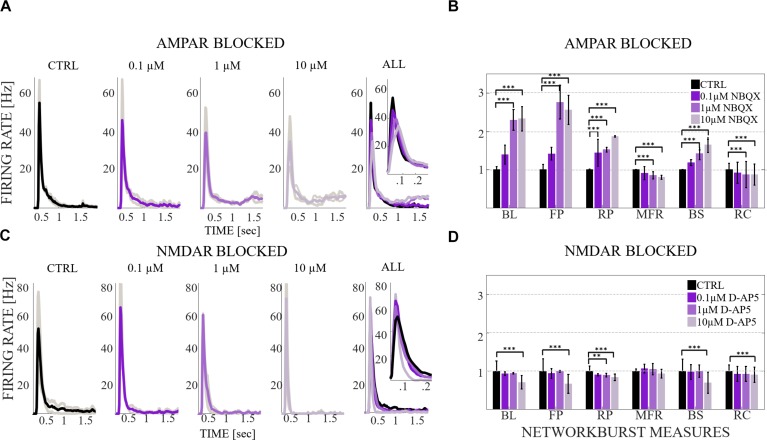FIGURE 7.
The influence of gradual application of the excitatory receptor antagonists on NB profiles and burst measures. (A) The burst profiles [Hz] from two congruent experiments where the data of the CTRL recording (1st subpanel) is compared to the data of the recording conditions when AMPARs (2nd, 3rd, and 4th subpanels) are antagonized with 0.1, 1, and 10 μM NBQX. Thin gray lines represent the average NB profiles of each culture in each condition, whereas the thick line represents the average over both cultures. The profiles are aligned with each other at the time point when the MFR is reached. The presented profiles are computed using the spike-data from Figure 6, processed as described in section “Materials and Methods”. The 1st, 2nd, 3rd, and 4th subpanels show the first 1.5 s of burst profiles. The 5th subpanel shows all four average NB profiles in the same panel and enlargement of the first 300 ms of all four profiles to display the fine details at the beginning of the NBs. Bin width is 0.01 s. (B) The relative change of characteristic burst measures extracted from burst profiles, including BL, FP, RP, MFR, BS and RC (see section “Materials and Methods”). Each bar represents the mean of the medians ± SD divided by mean, i.e., coefficient of variation from both cultures. The top panel shows the relative change in networks probed by a gradual blockade of AMPARs (0.1, 1, and 10 μM NBQX). (C) Same as (A) except that the data of the CTRL recording (1st subpanel) is compared to the data of the recording conditions when NMDARs (2nd, 3rd, and 4th subpanels) are antagonized with 0.1, 1, and 10 μM D-AP5. (D) Same as (B) except that the relative change in networks is probed by a gradual blockade of NMDARs (0.1, 1, and 10 μM D-AP5). Wilcoxon rank sum test and p-values were computed for all burst measures in each condition and in each culture. If the tests showed a similar result for both cultures, the significance was displayed in (B,D). BL, FP, RP and BS gradually increased by a gradual AMPAR blockade (B) and gradually decreased by a gradual NMDAR blockade (D). MFR gradually decreased by AMPAR blockade (B). RC decreased by both AMPAR and NMDAR blockades (B,D). ∗∗∗pranksum < 0.001, ∗∗pranksum < 0.01, ∗pranksum < 0.05.

